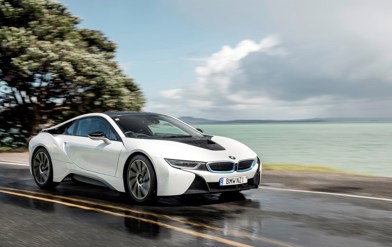For all its brand-cred and Kiwi heritage, one thing the Toyota Hilux has struggled with in recent years is offering a range-topping model that looks and feels as special as the equivalent Ford Ranger (even Nissan is having a good try with the likes of the Navara Pro-4X).
The Hilux SR5 Cruiser was certainly a step in the right direction, but still not quite there; it's never truly stood out from the rest of Hilux lineup. So Toyota has taken another step with the same model to create the SR5 Cruiser 4WD "wide track". The quotation marks are there because it doesn't really have a special name; the changes apply to all SR5 Cruiser 4WD models, just not to any other variant (not even the SR5 Cruiser PreRunner 2WD).

Your eyes do not deceive: the Cruiser has bulked up Sam Wallace-style with 140mm-wider track (hence the huge wheelarch extensions) and a 20mm increase in ride height. It's been done properly, mind: the front suspension arms/stabiliser bar have been lengthened, with the shock absorbers repositioned. At the rear, the solid axle has been lengthened, the dampers have been moved further out and, for the first time on Hilux, a rear stabiliser bar has been fitted; Toyota says it's now 20 per cent less roly-poly in corners.
It has slightly larger brakes up front (only by an inch), and actual ventilated discs at the rear instead of the usual drums.
Toyota has also thrown a few extra active safety features into the SR5 Cruiser package, including Blind Spot Monitor (BSM) and Rear Cross Traffic Alert (RCTA).
Ranger is always always the elephant in the room. It's tempting to compare SR5 Cruiser (the Hilux flagship) to Raptor (the Ranger flagship) and then be highly critical of the Toyota, because it retains the standard 150kW/500Nm engine. Many do and many have.

That's not the idea of this Cruiser, of course. It's probably closest in concept to the Ranger Wildtrack biturbo (which also shares its engine with lesser models). It's fair to say the Ranger goes a lot further on distinctive design and luxury, whereas the Hilux's USP is all about those comprehensive chassis changes.
Worth noting, too, that the SR5 Cruiser Wideboy (sorry, couldn't resist) is $63,390 - a whopping $12k less than the Ranger Wildtrak BiT. It's a lot of one-tonner for the money in a New Zealand context, especially when you consider that the Toyota is actually more expensive than its Ford rival in Australia.
The other (perhaps real) reason for Toyota investing so much under the skin for the SR5 wide track is that it provides the base for the forthcoming Hilux GR Sport model (that's it in red, below), which has been confirmed for NZ and is imminent.

The updated SR5 Cruiser also means the end of the Toyota NZ-developed Mako, because the local upgrades aren't compatible with the wider platform. Besides, this town ain't big enough for a Mako and a GR Sport.
The SR5 Cruiser 4WD certainly has a lot more presence than a regular Hilux. The chunky styling of the standard model takes on a whole new level of aggression with that extra width and height.
Toyota has always been firm abut the Hilux being a work-truck first, so you have to accept some elements of the package are more agricultural than rivals. The 2.8-litre diesel is right up there for power and torque (it matches the Ranger Wildtrak), but the levels of noise, vibration and harshness (NVH) are relatively high. And the SR5 Cruiser "only" has a six-speed gearbox, so you really have to focus on surfing that 500Nm for smooth on-road progress.

But the enhanced stability really comes to the fore in open-road driving. The SR5 Cruiser is planted and stays relatively roll-free in quick corners; it's by no means a sports ute, but it's a lot more stable and confident-feeling than any Hilux that has come before. On narrow backroads you just have to remember that you might be taking up more than your fair share of blacktop: this Hilux is over two metres wide.
The opportunity cost for capable cornering is a very firm ride that never really settles, even in urban driving. It's not bad for a trad-ute, but it's certainly not up to the more comfortable standards of more contemporary one-tonners.
Ditto for the cabin, which is loaded in SR5 Cruiser trim, but still betrays its workhorse origins with hard plastics and fairly basic design. The luxury garnish includes leather upholstery (single-temp heated seats up front), dual-zone climate air-condition, touch screen with phone projection (tethered, not wireless), uprated JBL audio and special "Optitron" instruments - which are old-school analogue rather than digital, but nothing wrong with that; they're clear and look really smart.

The Toyota delivers on driver assists; Hilux was the earliest adopter of comprehensive active safety tech in the ute segment, after all. It boasts autonomous braking with pedestrian/cyclist detection, lane departure warning/assist (done by braking rather than steering) and adaptive cruise control - although annoyingly, it quits at 30km/h.
The Hilux is still showing its age in some respects - this is an update of a model that was new back in 2018, after all. But if the mission was to introduce a truly special Hilux variant to the range, then the new SR5 Cruiser succeeds. It's a lot of truck for $63k, rather appealing on an emotional level when you consider what the Hilux name means to Kiwis, and a stepping stone/sister model to the Hilux GR Sport.
TOYOTA HILUX SR5 CRUISER 4WD
ENGINE: 2.8-litre turbo diesel four
POWER: 150kW/500Nm
GEARBOX: 6-speed automatic, part-time 4WD
CONSUMPTION: 9.5 litres per 100km, CO2 252g/km (3P-WLTP)
PRICE: $63,390 (Clean Car fee $3795)





















